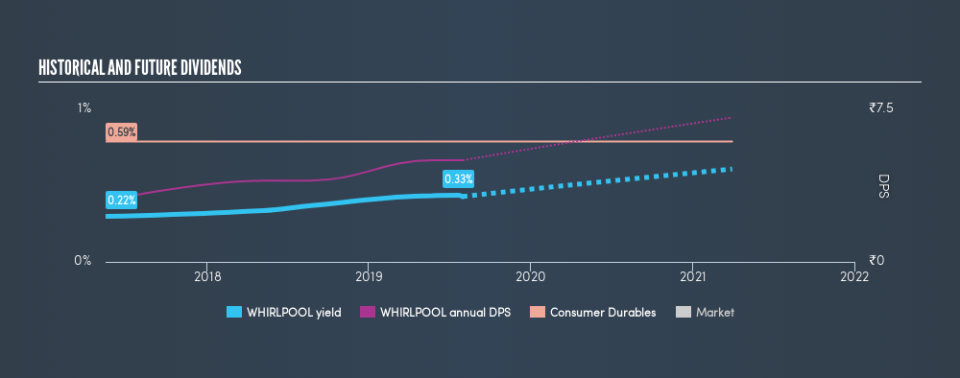Whirlpool of India Limited (NSE:WHIRLPOOL) Passed Our Checks, And It's About To Pay A 0.3% Dividend

Whirlpool of India Limited (NSE:WHIRLPOOL) stock is about to trade ex-dividend in 3 days time. You will need to purchase shares before the 5th of August to receive the dividend, which will be paid on the 12th of August.
Whirlpool of India's upcoming dividend is ₹5.00 a share, following on from the last 12 months, when the company distributed a total of ₹5.00 per share to shareholders. Based on the last year's worth of payments, Whirlpool of India has a trailing yield of 0.3% on the current stock price of ₹1554.45. Dividends are an important source of income to many shareholders, but the health of the business is crucial to maintaining those dividends. We need to see whether the dividend is covered by earnings and if it's growing.
See our latest analysis for Whirlpool of India
Dividends are typically paid from company earnings. If a company pays more in dividends than it earned in profit, then the dividend could be unsustainable. Whirlpool of India has a low and conservative payout ratio of just 15% of its income after tax. A useful secondary check can be to evaluate whether Whirlpool of India generated enough free cash flow to afford its dividend. The good news is it paid out just 23% of its free cash flow in the last year.
It's positive to see that Whirlpool of India's dividend is covered by both profits and cash flow, since this is generally a sign that the dividend is sustainable, and a lower payout ratio usually suggests a greater margin of safety before the dividend gets cut.
Click here to see the company's payout ratio, plus analyst estimates of its future dividends.
Have Earnings And Dividends Been Growing?
Businesses with strong growth prospects usually make the best dividend payers, because it's easier to grow dividends when earnings per share are improving. Investors love dividends, so if earnings fall and the dividend is reduced, expect a stock to be sold off heavily at the same time. That's why it's comforting to see Whirlpool of India's earnings have been skyrocketing, up 27% per annum for the past five years. Whirlpool of India looks like a real growth company, with earnings per share growing at a cracking pace and the company reinvesting most of its profits in the business.
The main way most investors will assess a company's dividend prospects is by checking the historical rate of dividend growth. In the past 2 years, Whirlpool of India has increased its dividend at approximately 29% a year on average. It's great to see earnings per share growing rapidly over several years, and dividends per share growing right along with it.
The Bottom Line
Is Whirlpool of India an attractive dividend stock, or better left on the shelf? Whirlpool of India has been growing earnings at a rapid rate, and has a conservatively low payout ratio, implying that it is reinvesting heavily in its business; a sterling combination. It's a promising combination that should mark this company worthy of closer attention.
Curious what other investors think of Whirlpool of India? See what analysts are forecasting, with this visualisation of its historical and future estimated earnings and cash flow .
We wouldn't recommend just buying the first dividend stock you see, though. Here's a list of interesting dividend stocks with a greater than 2% yield and an upcoming dividend.
We aim to bring you long-term focused research analysis driven by fundamental data. Note that our analysis may not factor in the latest price-sensitive company announcements or qualitative material.
If you spot an error that warrants correction, please contact the editor at editorial-team@simplywallst.com. This article by Simply Wall St is general in nature. It does not constitute a recommendation to buy or sell any stock, and does not take account of your objectives, or your financial situation. Simply Wall St has no position in the stocks mentioned. Thank you for reading.

